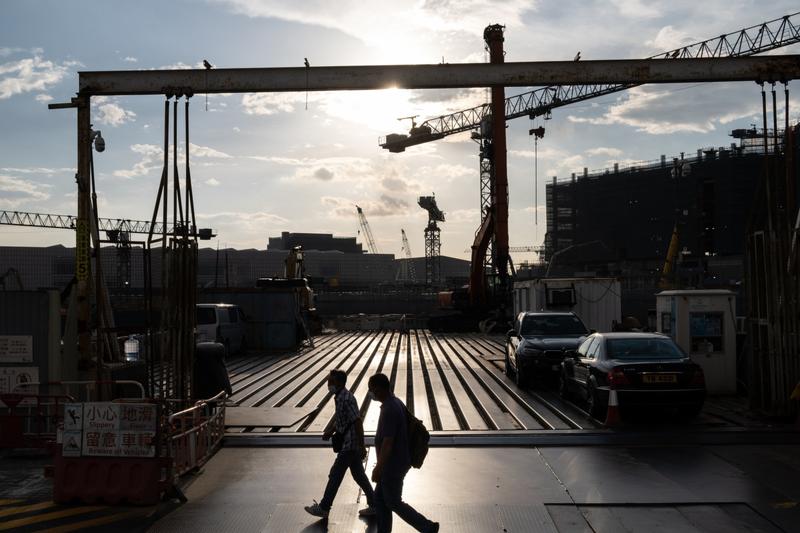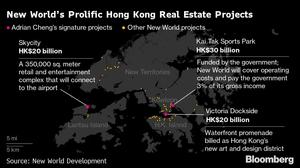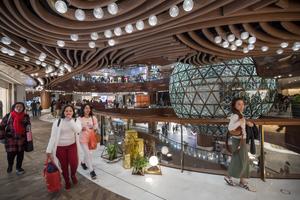 Pedestrians walk past a entrance of a construction site of the SkyCity mall in Hong Kong. (ROY LIU / BLOOMBERG)
Pedestrians walk past a entrance of a construction site of the SkyCity mall in Hong Kong. (ROY LIU / BLOOMBERG)
From building Hong Kong’s largest shopping mall to constructing a sprawling US$3.9 billion sports center, Adrian Cheng has been one of the most aggressive property investors in town. It’s a costly expansion strategy that’s now poised to test one of the city’s oldest real-estate empires.
Cheng, 40, became chief executive officer of New World Development Co in May, cementing his position after taking over from his father Henry a few years ago. But even as he ascended to the top, Cheng championed ambitious real-estate developments in the financial and tourism hub worth about US$5 billion. Conceived on the assumption Chinese mainland visitors would continue to throng the Hong Kong Special Administrative Region (HKSAR), they now mean the family is exposed to some of the city’s largest projects at a time when the coronavirus pandemic and social unrest is crippling its economy.
ALSO READ: Malls, shopping centers change with times
Few names are more synonymous with Hong Kong than the Chengs. New World built and operates the convention center where the handover ceremony for Hong Kong’s return to the motherland was held in 1997, and the family also controls Chow Tai Fook Jewellery Group Ltd, which has jewelry stores across the city.
Few names are more synonymous with Hong Kong than the Chengs. New World built and operates the convention center where the handover ceremony for Hong Kong’s return to the motherland was held in 1997, and the family also controls Chow Tai Fook Jewellery Group Ltd, which has jewelry stores across the city
Unlike the family of Li Ka-shing, Hong Kong’s richest man, which steadily reduced its exposure to the city over the past decade, New World still gets two thirds of its HK$76.8 billion (US$9.9 billion) in annual revenue from the HKSAR, and the big developments underway are set to entrench them further.
A Harvard graduate and former Goldman Sachs Group Inc investment banker, Cheng is now trying to pivot New World beyond the HKSAR’s shores, setting his sights across the border in Guangdong, where the central government is promoting its vision of a “Greater Bay Area” integrating the city with Shenzhen, Guangzhou and other metropolises in the Pearl River Delta.
But New World’s mainland plans, including more than 17 billion yuan (US$2.5 billion) in spending on several projects, along with its building spree in the HKSAR have left it with a debt-to-equity ratio of 42 percent-- the highest among the city’s biggest developers. That bet needs to pay off.
ALSO READ: NWD to offer 3m sq ft of farmland for public use
“We want to be the leading and the largest Hong Kong developer in the Greater Bay Area,” New World’s Deputy Chief Financial Officer Edward Lau said in an email. “We have a significant capex and growth plan.”
To fund his mainland strategy, Cheng is borrowing money and selling assets. His shift shows the challenges faced by the new generation of Hong Kong tycoons - from Li Ka-shing’s son and successor Victor Li to the Lee brothers who now run Henderson Land Development Co, the city’s third-largest property empire by market value.
Mainland Pivot
While its gaze may be swiveling to the mainland, New World’s long-running focus on the HKSAR has meant some of its most costly building projects are coming to fruition.
As executive vice-chairman in 2018, Cheng helped win a bid to build and operate a 28-hectare sports complex at the site of the HKSAR’s old airport, including a 50,000-seat stadium and 10,000-seat arena. It is targeted for completion in 2023. While the HKSAR government will fund the building cost of HK$30 billion, New World will cover all future operating costs and pay the government 3 percent of the complex’s gross income.

Cheng also spearheaded New World’s successful bid in May 2018 for a HK$20 billion shopping-and-entertainment complex at the airport. The 3.77 million-square-foot Skycity, scheduled to open in phases between 2023 and 2027, will include the biggest mall in the HKSAR, but is being built as retail sales in the city continue their year-long slump and tourism is almost non-existent given the virus border curbs.
Art and Culture
An arts patron who’s on committees of museums in New York, London and Paris, Cheng also drove the re-development of New World Centre, a group of drab 1970s buildings in the HKSAR’s Kowloon district, into Victoria Dockside, a US$2.6 billion office and commercial project which includes an art and culture complex.
“It’s impressive that New World won a lot of contracts, mostly related to Adrian Cheng’s energetic and aggressive style,” said Simon Lee, co-director of the international business and mainland enterprise program at the Chinese University of Hong Kong. “But New World paid lots of money in getting those contracts and we don’t know if the tourism market will rebound.”
ALSO READ: The art of healing
That uncertainty is likely to be reflected in New World’s earnings, due to be reported next week. As the pandemic batters its businesses, adjusted net income in fiscal year ended June is likely to drop about 12 percent from 2019 to HK$7.9 billion, the steepest slide since 2011, according to the average of 12 analysts’ estimates compiled by Bloomberg. New World declined to make Adrian Cheng available for an interview.
The Hong Kong that Cheng is operating in is a different place to the boom town where his grandfather Cheng Yu-tung got his start. The company patriarch was an apprentice at the Macao gold shop of a family friend, Chow Chi Yeun, who founded Chow Tai Fook. He then married Chow’s daughter and eventually used the profits from selling gold to get into the property market, founding New World in 1970. These days, his son Henry, still New World’s chairman, is the HKSAR’s second-richest man with a US$20 billion fortune.
Mixed Success
The Chengs have made efforts over the years to diversify out of the HKSAR, but with mixed success. A partnership with Donald Trump to build the Riverside South buildings on Manhattan’s West Side soured, with Trump filing an unsuccessful lawsuit. The HKSAR investors eventually sold the project. The Chengs have bought an Irish plane leasing company, an Australian utility and a resort in the Bahamas.
“In the past, people thought diversification was good, but now there are risks in overseas markets,” said Raymond Cheng, an analyst at CGS-CIMB Securities, who has an add rating for New World’s stock.
ALSO READ: Billionaire's HK tower already 70% leased before 2018 opening
That means expansion into the mainland probably offers New World one of the few new avenues of growth. New World has invested in six urban redevelopment projects in Guangdong, according to the company, and plans to open 36 of its K11-brand retail and commercial projects in nine mainland cities and in the HKSAR by 2025. It currently has 12 such projects. In August, New World won a 4.1 billion yuan bid for an upscale commercial complex site in central Shanghai, triggering an effusive statement from the company’s mainland subsidiary hailing the new boss’s “extraordinary assertiveness, sharp and unique insight, and innovative business thinking.”
Better Returns
Funding such expansion has seen New World sell US$1.45 billion of bonds in 2020, about 7 percent of the record US$20 billion in offshore corporate bonds that analysts say were issued by HKSAR and Macao borrowers this year. The company is raising funds in a strategic way to help it generate returns that exceed the cost of debt, said Lau, the deputy CFO.
 Shoppers walk through the K11 Musea shopping mall in Hong Kong. (PAUL YEUNG / BLOOMBERG)
Shoppers walk through the K11 Musea shopping mall in Hong Kong. (PAUL YEUNG / BLOOMBERG)
Still, it’s borrowing much more than its peers. During the same period, the HKSAR’s other large indebted developers raised a combined US$2.2 billion, according to data compiled by Bloomberg.
“This is a lot of US dollar bonds for investors to digest given they are also vulnerable to bad headlines,” said Owen Gallimore, head of credit strategy at Australia & New Zealand Banking Group Ltd in Singapore. “The New World group has always run with the highest leverage among the Hong Kong property blue chips and more onshore exposure. Bond investors aren’t adequately compensated for the risk at the moment.”
Non-Core Assets
In the fiscal year through June 2020, New World sold more than HK$10 billion in assets, including its stake in a major shopping mall adjacent to the Macao ferry terminal. It recently agreed to sell HKSAR public bus routes it owns to a consortium of investors for HK$3.2 billion.
New World says it’s targeting to dispose of HK$15 billion of what it calls non-core assets in the fiscal year ending June 2021. These sales are meant to fund Cheng’s bet on a new future. Yet, it’s also one that’s looks more uncertain.
READ MORE: HK sees massive wealth transfer from tycoons to heirs
So far, investors seem to be taking a wait-and-see approach. Shares of New World are down 11 percent in 2020 amid a 22 percent slump in the Hang Seng Properties Index. Spreads on the company’s 6.25 percent perpetual bond widened about 116 basis points over the same period, a 28 percent jump and largely in line with the broader Asian dollar bond market, data compiled by Bloomberg show.
“It’s a testing time for the Cheng family businesses, especially for Adrian Cheng,” said Jackie Yan, a professor who specializes in corporate management and strategy at the University of Hong Kong. “He must be under some pressure to prove the new business model actually works.”


